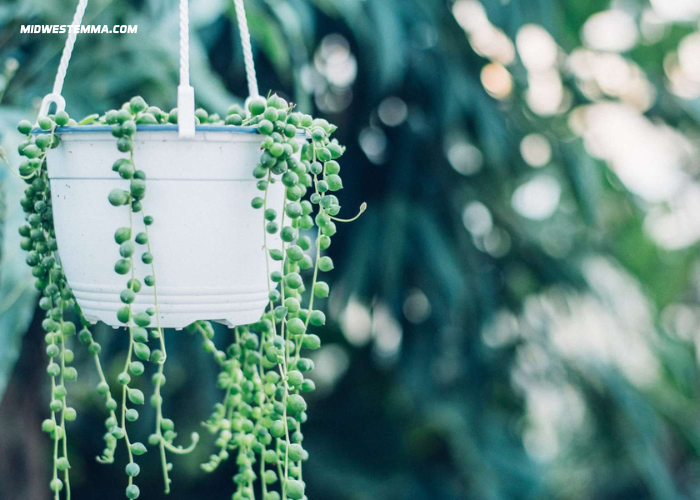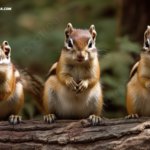The world of indoor gardening is a haven for plant enthusiasts seeking unique and captivating additions to their botanical collections. One such gem that has taken the gardening world by storm is the Blue String of Pearls plant (Senecio rowleyanus ‘Blue’), a mesmerizing succulent known for its distinctive appearance and easy care requirements. In this article, we delve into the fascinating aspects of this plant, from its origin and characteristics to its cultivation and care tips.
Unveiling the Origins and Characteristics
The Blue String of Pearls plant, a variation of the well-loved String of Pearls (Senecio rowleyanus), is a member of the Asteraceae family. Native to the arid regions of southwest Africa, this succulent has earned its popularity due to its enchanting blue-gray foliage that cascades gracefully from hanging baskets or containers. The plant derives its name from the spherical, bead-like leaves that resemble a string of pearls, adding a touch of elegance to any space it graces.
The leaves of the Blue String of Pearls are characterized by their striking blue hue, a unique feature that sets it apart from its traditional green counterpart. The cylindrical leaves are around a quarter of an inch in size and can grow up to an inch long. When allowed to grow freely, the trailing stems can reach lengths of up to two feet, creating an exquisite draping effect that adds an ethereal quality to indoor spaces.
Cultivation and Care Guidelines
Caring for the Blue String of Pearls plant is relatively straightforward, making it an ideal choice for both novice and experienced gardeners. Following a few key guidelines ensures the plant thrives and retains its captivating appearance:
- Light Requirements: Adequate light is essential for the health of the Blue String of Pearls plant. Place it in bright, indirect sunlight for a few hours each day. However, avoid exposing it to intense, direct sunlight, as it can lead to sunburn and damage the delicate foliage.
- Soil and Potting: Plant the Blue String of Pearls in well-draining soil to prevent waterlogging, as these succulents are highly sensitive to excess moisture. A mixture of cactus or succulent potting mix and perlite can provide the necessary drainage. Opt for a shallow, hanging container to allow the trailing stems to drape beautifully.
- Watering: Succulents are known for their water-saving abilities, and the Blue String of Pearls is no exception. Water the plant thoroughly, allowing the soil to dry out completely between waterings. During the growing season (spring and summer), water more frequently, but reduce watering in the dormant period (fall and winter).
- Temperature and Humidity: These plants thrive in average room temperatures, typically ranging from 65 to 75 degrees Fahrenheit (18 to 24 degrees Celsius). They can tolerate slightly cooler temperatures during the winter dormancy period. While the Blue String of Pearls plant appreciates higher humidity levels, it can adapt to average household humidity.
- Fertilization: Feed the Blue String of Pearls with a diluted, balanced liquid fertilizer every 4 to 6 weeks during the growing season. Avoid over-fertilization, as excessive nutrients can lead to leggy growth.
- Propagation: Propagating the Blue String of Pearls is a rewarding endeavor. Cuttings can be taken from healthy stems, allowed to dry for a day or two, and then planted in well-draining soil. Keep the soil consistently moist until roots develop.
Enhancing Interior Aesthetics
The Blue String of Pearls plant’s distinctive appearance makes it a favored choice for interior decoration. Its cascading growth habit adds a touch of elegance and visual interest to various settings, making it suitable for a range of design styles.
- Hanging Baskets: Hanging baskets are a popular choice for showcasing the Blue String of Pearls plant. The trailing stems create a waterfall effect, making it a captivating focal point. Hang the baskets near windows or in well-lit areas to allow the plant to receive ample indirect sunlight.
- Shelving and Ledges: Placing potted Blue String of Pearls plants on shelves or ledges allows the delicate foliage to spill gracefully over the edges, adding a whimsical touch to any room. Combine them with other succulents or decorative items for an aesthetically pleasing display.
- Terrariums: Creating a mini desert landscape within a glass terrarium can be a creative and eye-catching way to showcase the Blue String of Pearls. The glass enclosure provides the necessary humidity while allowing you to observe the plant’s growth up close.
Common Challenges and Troubleshooting
While the Blue String of Pearls plant is relatively low-maintenance, it’s essential to be aware of potential challenges that can arise:
- Overwatering: One of the most common mistakes is overwatering. Excessive moisture can lead to root rot and other issues. Ensure the soil dries out between waterings to prevent this problem.
- Pests: Like other succulents, the Blue String of Pearls can be susceptible to pests such as mealybugs and aphids. Regularly inspect the plant and take action promptly if you notice any infestations.
- Leggy Growth: Insufficient light can result in leggy growth, where the stems become elongated and spaced out. To prevent this, provide adequate indirect sunlight and consider rotating the plant occasionally to ensure even growth.
Captivating Variations and Complementary Plants
As the popularity of the Blue String of Pearls plant continues to grow, breeders have introduced variations that offer even more visual diversity. Varieties with different leaf sizes, shapes, and colors have emerged, allowing enthusiasts to curate unique collections.
- Blue Chalksticks (Senecio serpens): Pairing the Blue String of Pearls with the Blue Chalksticks plant can create a stunning contrast. The Blue Chalksticks feature finger-like leaves with a gray-blue hue, complementing the spherical pearls of the Blue String of Pearls.
- Echeveria Varieties: Echeverias, with their rosette-like foliage and various colors, can be excellent companions to the Blue String of Pearls. The combination of trailing and rosette growth forms adds visual interest.
Conclusion
The Blue String of Pearls plant’s allure lies not only in its striking appearance but also in its adaptability and ease of care. Whether adorning a windowsill, hanging gracefully from a basket, or cascading over a shelf, this succulent brings an elegant touch of nature to indoor spaces.
As you embark on your journey with the Blue String of Pearls, remember to embrace its unique characteristics and provide the care it deserves to thrive and enchant for years to come.









